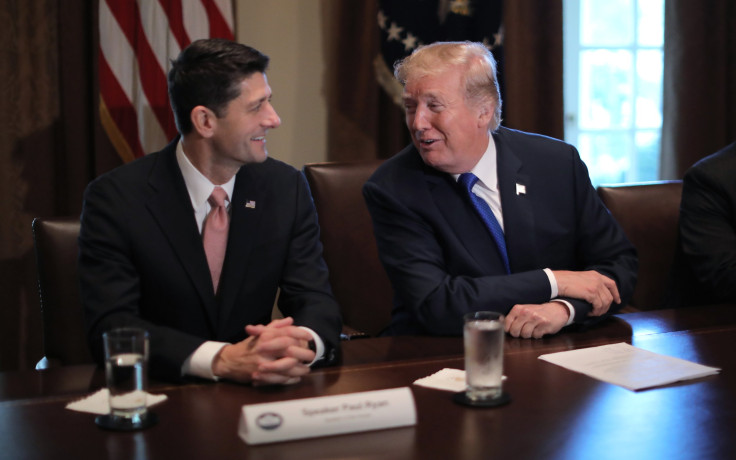‘Voodoo Economics’ Makes A Comeback In Republican Tax Plan Enriching The Rich

Republicans in Congress recently released more details of their tax plan, which they say would boost economic growth and lower the burden on middle-income households. They hope to pass a bill into law by Christmas.
The reality is that the proposed cuts, which carry a price tag as high as US$1.5 trillion over a decade, would offer the greatest relief to corporations and the wealthy.
Simply put, the plan reflects the thinking of supply-side economics, whereby tax cuts to top earners are said to result in more business investment. Lowering taxes for the wealthy and companies, the theory goes, fuels a benevolent cycle that ultimately leads to higher wages and a stronger economy.
I have worked on a wide range of economic policy topics, including taxes, for two decades now. Evidence from past changes suggests that the tax plan would do little to increase business investment or help workers. Instead, it would increase the gap between rich and poor, while leaving massive budget deficits in its wake.

Supply Side In A Nutshell
Republicans these days don’t often use the term “supply-side economics,” which has been pejoratively dubbed “trickle-down” or even “voodoo” economics – the latter by none other than former President George H. W. Bush.
Instead, Republicans and President Donald Trump continue to make the false claim that their plan would mostly benefit middle-class Americans. In contrast, an economic analysis of the tax plan framework released last month showed that half of the proposed cuts would go to the top 1 percent.
The latest version is unlikely to significantly change that result. While the 39.6 percent tax rate will remain, the threshold has been more than doubled to US$1 million from less than $500,000, meaning earnings up to that point will be subject to less tax, and the plan would still get rid of the estate tax, which is mostly paid by wealth families. In addition, two-thirds of the benefits – about $1 trillion – will go to companies, which, as I’ll explain, primarily benefit the rich as well.
In any case, here’s the theory of how cutting taxes for the wealthy leads to more growth and jobs. The wealthy would use the lion’s share of their tax savings to invest in new and existing businesses. This would drive more economic growth, leading to increased levels of productivity, more jobs and higher wages.
Tax cuts to companies would also give the economy a kick. Companies could in theory use some of their increased profits to finance new plants, office space and equipment, and the lower rates would induce more foreign businesses to invest in the United States, altogether boosting jobs, productivity and wages.
President Trump’s Council of Economic Advisers claims that the corporate tax cuts alone would boost economic growth to 3 percent to 5 percent a year.
Past Tax Changes
Research on past tax changes suggests that the Republican tax plan will not have the impact its backers claim.
Four large-scale tax changes in the past four decades help to illustrate these points: tax cuts in 1981 and 2001 and tax increases in 1993 and 2012. I compared what happened to business investment, employment, wages and economic growth before and after each tax change.
In August 1981, Congress lowered personal income tax rates – especially for high-income earners, who saw a drop in the top tax rate from 70 percent to 50 percent – as well as the corporate rate. Similarly, two decades later Congress cut personal income tax rates and the estate tax.
So what happened? Business investment, clearly a key metric in evaluating the success of the supply-side tax cut argument, was virtually flat as a share of gross domestic product after the 1981 cuts. Following the June 2001 cuts, it actually fell, from 13.8 percent in the month the bill passed to under 12 percent three years later.
As for jobs and wages, their growth increased only a little after the 1981 tax cuts and actually slowed in the three years after the 2001 tax cuts were passed.
The flip side of the supply-side argument is that any increase in taxes should have the opposite effect: less investment, slower growth, fewer jobs and stagnant wages. Empirical evidence suggests otherwise.
In August 1993, Congress raised the top marginal tax rate to 39.6 percent from 35 percent on high-income earners. Lawmakers raised the top rate again at the end of 2012, while also increasing the estate tax.
Business investment grew after the 1993 tax increase, from 11.6 percent of GDP to 13 percent three years later. And it grew after the 2012 one as well, albeit more slowly, from 12.5 percent in December that year to 12.7 percent in 2015 (though it reached 13.1 percent a year earlier).
Jobs and wages tell a similar tale, both of which grew at a faster pace after the tax changes.
As for economic growth, supply-side policies do not tend to result in a stronger economy. While growth jumped immediately after the 1981 cuts, the economy quickly lost steam. And in 2001, GDP barely budged. Meanwhile, growth accelerated modestly in the years after the tax increases in both 1993 and 2012.
Proponents of such policies think that by giving more money to the “supply side” of the economy, the wealthy and investors who manage the capital necessary for productive investments such as manufacturing plants or new trucks and computers, they can spur long-term economic growth.
The data show this is not the case. Long-term economic performance is little different whether you cut or raise taxes on the richest Americans. Other research on the impact of corporate cuts also shows this.
Rather than wasting money on supply-side tax cuts that line the pockets of the wealthy and corporations that have already seen outsized gains in income, the money could be much better spent on more infrastructure – bridges, roads and canals – and on education. Over the long term, this is what drives productivity and economic growth – not more money to the wealthy – because this leads to more business investment, higher wages and more jobs.
Stock Market Reaction Explained
So why do investors appear so ecstatic over the prospect of tax cuts and continue to drive major stock indexes to fresh highs?
Because they’re the ones who would get most of the gains from the cuts, whether because they’re already wealthy or because a growing share of corporate after-tax profits are used to keep shareholders happy through share repurchases and dividend payouts. In fact, virtually all profits have been spent on shareholders in the past two decades, compared with around a third or less in the decades before the 1980s.
Another part of the supply-siders’ argument in favor of a lower corporate tax rate is that it would make the U.S. a more attractive place for foreign companies to invest. Yet overseas businesses are already investing a growing amount of money in the United States, regardless of the relatively high statutory tax rate. This suggests that their investments are likely driven by considerations other than the tax rate, such as by skill level of the local labor force, access to markets, a sound legal system and good infrastructure.
Republican Voodoo
In sum, there’s little if any evidence to support the notion that tax cuts for high-income earners and companies will trickle down to average Americans.
The government would lose revenue by passing these tax cuts without any clear offsetting economic benefits. To make budgets add up, Congress would have to accept larger deficits or force spending cuts on vital programs in health care, education, retirement and social services.
All told, this would further exacerbate already very high income inequality. That is clearly the 21st century’s definition of “voodoo economics.”
Christian Weller is Professor of Public Policy and Public Affairs at University of Massachusetts Boston.
This article was originally published in The Conversation. Read the original article.





















